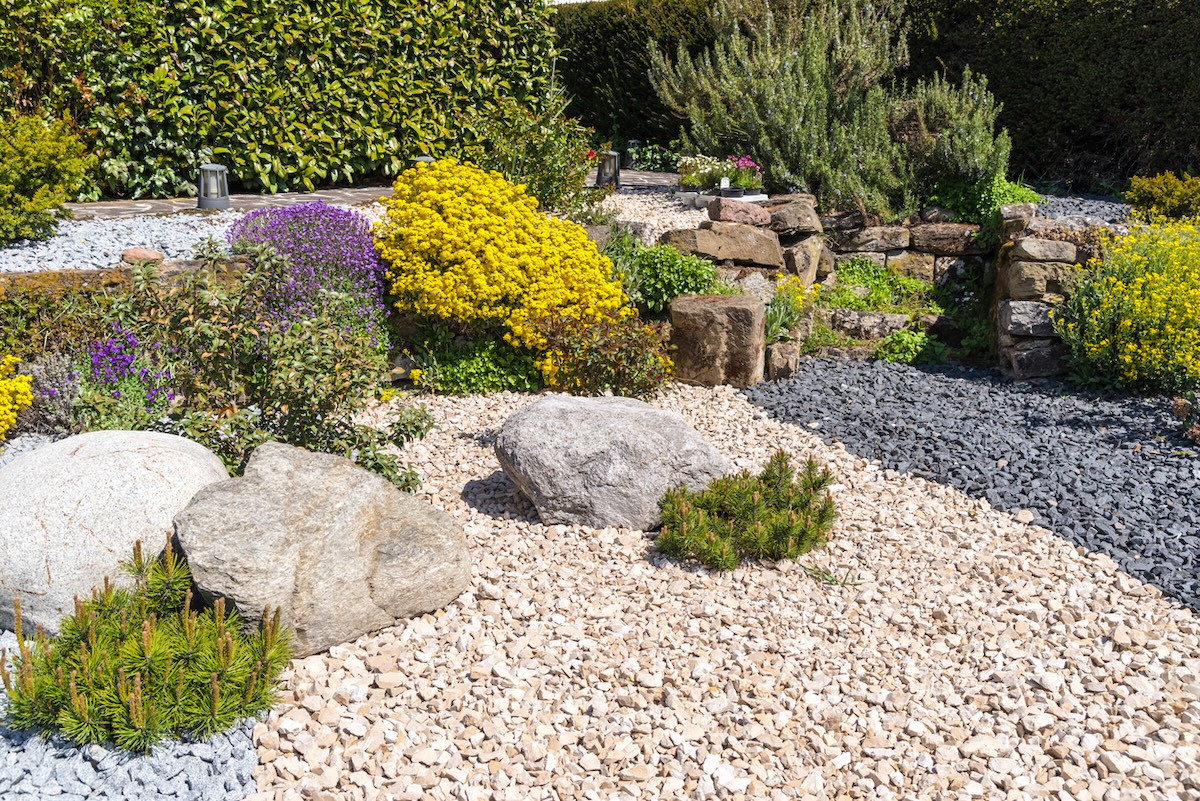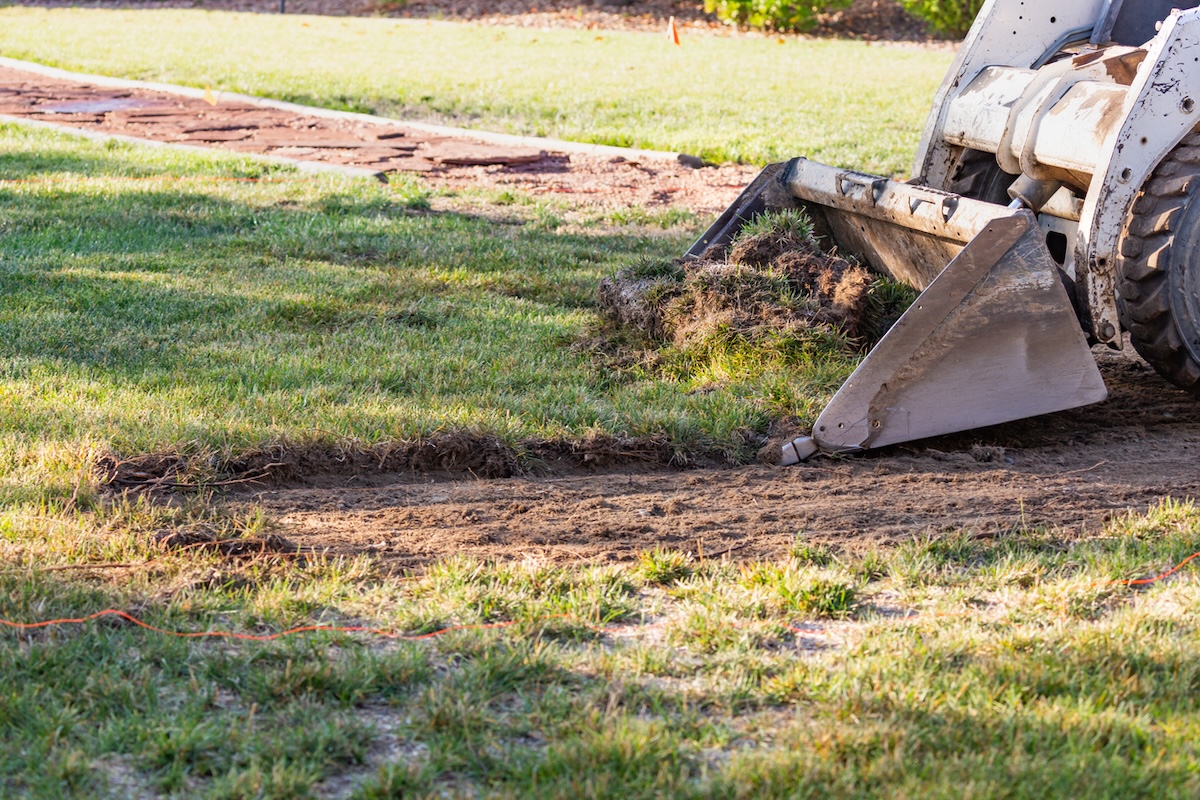We may earn revenue from the products available on this page and participate in affiliate programs. Learn More ›
In recent years, extreme heat and droughts have become increasingly common. According to the National Integrated Drought Information System’s U.S. Drought Monitor, 22 states are currently experiencing moderate drought or worse. These conditions have spurred calls for water conservation, including mandated water restrictions in certain jurisdictions.
While xeriscape landscaping began out West, it can be part of the solution for gardeners in other regions, helping to reduce water usage by about 50 percent. “Climate change has made xeriscaping more important and more popular than ever,” says Randy Schultz of Colorado Springs, Colo. He is founder and editor of Home Garden and Homestead and author of The Complete How-To Guide to Xeriscaping. “Homeowners are much more aware of how their landscapes impact their local communities and the available water sources,” says Schultz.
Discover exactly what is xeriscaping, the pros and cons of this landscaping approach, the key principles to follow, the best xeriscape ideas, and whether it’s a good fit for your yard.
What Is a Xeriscape, Anyway?

Xeriscaping (pronounced “zir-uh-skape-ing”) combines the Greek word for dry (“xeros”) with the word “landscaping”. Coined by the Denver Water Department in 1981, the term “xeriscape” pertains to the practice of designing water-efficient landscapes to reduce or eliminate the need for irrigation.
According to Schultz, “Over time, the term has broadened to embrace the concept of landscaping and gardening that’s appropriate for local climate conditions using native and adapted plants.” The approach has been particularly embraced in dry regions of the western United States to address drought concerns.
Xeriscaping follows seven focus areas: planning and design, soil analysis and improvement, selecting proper plants, creating practical turf areas, irrigating efficiently, using mulches, and administering proper maintenance. Such landscapes typically include plants with low water needs, natural landscaping using native plants, rainwater harvesting, rain gardens, and replacing turf grass with drought-tolerant grass or hardscaping.
The Pros and Cons of Xeriscaping
Before proceeding with creating a xeriscape garden or xeriscape front yard, it’s important to evaluate the benefits and drawbacks of this type of landscape design. From a number of environmental benefits to saving money and maintenance time, xeriscaping offers many pros. However, this approach does not come without some challenges as well.

Pros:
- Conserves water. “The biggest benefit is water savings,” says Schultz. “That’s an environmental benefit, and it’s a money-saving benefit, too.”
- Preserves native plants. Natives are already adapted to the local climate, including typical rainfall, and do not need as much irrigation to thrive.
- Attracts pollinators. Choosing natives as xeriscape plants ends up bringing more birds, bees, and butterflies to the yard.
- Requires less maintenance. “If you choose plants that love the growing conditions in your area, and love the growing conditions in the microclimates of your property, those plants will thrive,” says Schultz. “That means less time spent watering, pruning, fertilizing, and replacing plants that died because they weren’t a good fit for the growing conditions.”
- Spruces up the area. When done creatively, xeriscaping can be stunning and boost curb appeal. A xeriscape front lawn also looks tidy and attractive year-round.
- Provides multiple environmental benefits. In addition to saving water, xeriscaping lowers surface temperature; supports local wildlife; reduces the use of chemicals like pesticides, weed killers, and fertilizers; minimizes pollution; and helps with groundwater recharge and soil infiltration.
Cons:
- Requires initial financial investment. Xeriscaping can cost anywhere from $5 per square foot to $20 per square foot to implement compared to $4.50 to $17 per square foot for traditional landscaping. However, maintenance costs are less, so in the long run it can actually save money.
- Takes time and patience. The process of creating a xeriscaped lawn can take months or longer, involving working with a designer, hiring landscaping pros to remove grass and other non-native plants, nurturing the soil back to health, and waiting for plants to grow from seed.
- Involves adjusting to a new look. Some people might miss having a lush, turf-filled green lawn and be turned off by low-water landscaping options.
- Causes potential runoff problems. Unfortunately, when the turf grass is removed, that can trigger increased nitrogen leaching and sediments entering waterways. This can impact aquatic wildlife and public health as a result of potential harmful algal blooms.
The 7 Principles of Xeriscaping
There are seven principles of xeriscaping that were developed by Denver Water, which are still followed today. Each of these principles is discussed below.

1. Planning and Design
Start with a plan to determine the direction of water-saving techniques to implement. First, look at the existing landscape and create a base plan that includes a diagram drawn to scale showing the house; sidewalk; driveway; deck or patio; trees, shrubs, and plants; garden beds, fences; spigots and downspouts; and other key elements. Be sure to measure parts of the landscape, such as property lines, exterior walls, hardscape, and all vegetation.
Laying everything out clearly can make it easier to design the rest of the landscape and add xeriscape elements such as native plants. Finally, use these details to evaluate the budget, appearance, function, and maintenance requirements for the yard.
2. Soil Improvements
Fortunately, with xeriscaping, fewer pesticides are required to address pests. This helps protect the soil by retaining many of the beneficial organisms that live in the soil. According to Denver Water, clay soil is dense and takes a long time to absorb and release water, while sandy soil doesn’t hold much water. Plants in sandy soils tend to dry out more easily. Additionally, non-native plants might require use of soil amendments, which typically entails adding organic material such as compost or manure to help retain and release water.
3. Efficient Irrigation
Efficient irrigation is a core aspect of xeriscaping. “Xeriscaping began with water use in mind, so I think that’s still the fundamental principle that gardeners, homeowners, and landscapers need to keep in mind,” says Schultz. “In a world that’s getting hotter and drier, xeriscaping makes more sense than ever.”
There are several ways to engage in low-water landscaping. You can water by hand or by using an automatic drip irrigation system. Just avoid oscillating sprinklers and those that release water high up in the air or release a fine mist. Grass requires low-pressure, low-angle sprinklers, while trees, shrubs, and flowers are best irrigated using drip, spray, or bubbler systems. Drip irrigation is most beneficial since it distributes a low amount of water over an extended time, which helps reduce water loss.
Avoid watering between 10 a.m. and 6 p.m. to reduce water loss from evaporation. Adjust automatic watering systems based on the weather and install a rain sensor to shut off the system and avoid overwatering plants.

4. Plant Zones
Xeriscaping does not have to mean stark landscaping. Overall, it’s important to select vegetation based on its ability to adapt to the local climate and soil conditions. By combining natives with well-adapted exotic plants, you can create an attractive xeriscape backyard filled with color and textures relying on minimal water. Choose a mix of cacti, succulents, vines, groundcovers, grasses, perennials, and shrubs.
Xeriscaping emphasizes proper groupings of plants with similar water needs. Since different parts of the yard receive varying amounts of wind, light, and moisture, Denver Water advises that gardeners group together plants with similar light and water requirements. It is also recommended to plant vegetation that requires lots of water in low-lying drainage areas, in the shade, or near downspouts. On the other hand, low-water-use plants can grow in dry, sunny spots.
5. Mulches
Mulches are helpful for xeriscaped yards since the mulch layer helps keep plant roots cool, conserve moisture, minimize evaporation, and prevent soil compaction and crusting. According to the Texas Agricultural Extension Service, a good mulch helps conserve water by significantly reducing moisture evaporation from the soil.
Mulches can be organic materials such as pine bark, compost, and woodchips, or inorganic materials like lava rock, limestone, gravel, and permeable plastic. Denver Water recommends applying organic mulches at least 4 inches deep and inorganic mulches at least 2 inches deep.

6. Turf Alternatives
Certain grasses, such as Kentucky bluegrass, require a substantial amount of water to stay lush. Planting less turf will directly impact how much water a homeowner can save each year. As an alternative to turf, try native and low-water-use grasses like buffalo grass, blue grama grass, turf-type tall fescue, and fine fescues. Drought-tolerant ground covers like creeping thyme and ice plant also are options, especially on slopes or between steps in walkways. Opting for hardscape additions—such as stone walkways, rock gardens, patios, decks, pergolas, and retaining walls—can also reduce water usage while beautifying the yard.
7. Maintenance
It is typical for a xeriscaped landscape to require less maintenance than a lawn landscaped in a traditional way with grass and plants that rely on frequent watering. Additionally, the amount of work to manage a low-maintenance xeriscape front yard will actually decrease over time once plants become established. Another bonus with xeriscaping is that using fewer lawn mowers and leaf blowers contributes less to air pollution.
Xeriscape Cost (and Savings)
While the upfront costs of xeriscaping (up to $20 per square foot) are slightly higher than traditional landscaping, there are financial savings in the long run due to lower water bills and less maintenance costs. In addition, xeriscaping can increase property values by up to 15 percent, according to Colorado WaterWise.
Schultz shares his experience regarding cost savings. “Where I live in Colorado Springs (and in many cities in America), the cost of our water increases during the summer months based on how much water we use. It can get quite expensive to irrigate a large lawn during the summer. So, a properly designed xeriscape with a smaller lawn—or perhaps no lawn at all—can reduce your water bill by half or more,” he says.

Is Xeriscaping Right for Your Property?
Before embarking on an extensive landscaping makeover, it’s best to assess if xeriscaping is a good fit for the specific property. Schultz suggests that homeowners ask themselves what they want their yard to look like and the types of activities that will take place there. “A turfgrass area is a wonderful place for kids and grandkids to play,” he says. “But do you need a half-acre of lawn? Probably not. If you don’t want to give up your lawn completely, then plant a turfgrass variety that is appropriate for your climate,” says Schultz.
He also warns that some people might not enjoy the look of a desert landscape. “A classic xeriscape uses plants that are adapted to growing in drier climates. You might want to start with a small area of your yard as a xeriscape. Group those plants together and see if you like the look,” says Schultz. In fact, one of the principles of xeriscaping is about grouping plants with similar water needs together, so xeriscaping can be embraced even if you don’t xeriscape an entire property.
Likewise, those living in a normally humid climate don’t have to replace all their plants with succulents. Xeriscaping in that area might just mean opting for natives and plants that can survive on less rainfall than typical. Once you decide xeriscaping is right for your home, hire a professional landscaper who has experience with natives and xeriscapes. Choose someone who is knowledgeable about plants that are well suited to the local growing conditions.


